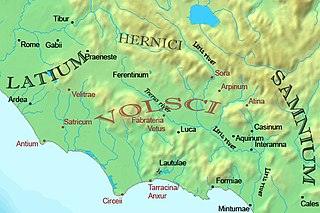Year 491 BC was a year of the pre-Julian Roman calendar. At the time, it was known as the Year of the Consulship of Augurinus and Atratinus. The denomination 491 BC for this year has been used since the early medieval period, when the Anno Domini calendar era became the prevalent method in Europe for naming years.

GnaeusMarcius Coriolanus was a Roman general who is said to have lived in the 5th century BC. He received his toponymic cognomen "Coriolanus" following his courageous actions during a Roman siege of the Volscian city of Corioli. He was subsequently exiled from Rome, and led troops of Rome's enemy the Volsci to besiege the city.
Year 493 BC was a year of the pre-Julian Roman calendar. At the time, it was known as the Year of the Consulship of Auruncus and Viscellinus. The denomination 493 BC for this year has been used since the early medieval period, when the Anno Domini calendar era became the prevalent method in Europe for naming years.

The Volsci were an Italic tribe, well known in the history of the first century of the Roman Republic. At the time they inhabited the partly hilly, partly marshy district of the south of Latium, bounded by the Aurunci and Samnites on the south, the Hernici on the east, and stretching roughly from Norba and Cora in the north to Antium in the south. Rivals of Rome for several hundred years, their territories were taken over by and assimilated into the growing republic by 300 BC. Rome's first emperor Augustus was of Volscian descent.
Corioli was a town in ancient times in the territory of the Volsci in central Italy, in Latium adiectum.
Postumus Cominius Auruncus was a two-time consul of the early Roman Republic.
The Roman–Volscian wars were a series of wars fought between the Roman Republic and the Volsci, an ancient Italic people. Volscian migration into southern Latium led to conflict with that region's old inhabitants, the Latins under leadership of Rome, the region's dominant city-state. By the late 5th century BC, the Volsci were increasingly on the defensive and by the end of the Samnite Wars had been incorporated into the Roman Republic. The ancient historians devoted considerable space to Volscian wars in their accounts of the early Roman Republic, but the historical accuracy of much of this material has been questioned by modern historians.
Publius Minucius Augurinus was a Roman Republican politician of the patrician gens Minucia during the beginning of the 5th century BC. He served as Consul of Rome in 492 BC
Titus Geganius Macerinus was a Roman politician who served as Consul in 492 BC with Publius Minucius Augurinus.
The Roman-Aequian wars were a series of wars during the early expansion of ancient Rome in central Italy against their eastern neighbours, the Aequi.
Spurius Nautius Rutilus was a Roman Republican aristocrat of the Patrician gens Nautia, who lived during the early 5th century BC. He served as Consul of Rome in 488 BC, with Sextus Furius as his colleague.
Attius Tullius was a well-respected and influential political and military leader of the Volsci in the early fifth century BC: according to Plutarch, who calls him Tullus Aufidius, his home town was Antium. Tullius sheltered the exiled Roman hero Gaius Marcius Coriolanus, then incited a war with Rome, in which he and Coriolanus led the Volscian forces. He appears in William Shakespeare's tragedy Coriolanus under the name of Tullus Aufidius.
Vitellia was an ancient town of Latium in central Italy.
Trebia was an ancient town of Latium in central Italy.
Lavici was an ancient town of Latium in central Italy, located near modern Colonna.
Pedum was an ancient town of Latium in central Italy, located between Tibur and Praeneste, near modern Gallicano nel Lazio. The town was a member of the Latin League.
Quintus Sulpicius Camerinus Cornutus was a Roman politician, and consul in 490 BC.
Publius Pinarius Mamercinus Rufus was a Roman senator who held the consulship alongside Gaius Julius Iulus in 489 BC.
Sextus Furius was a Roman politician from the early Republic, who served as consul in 488 BC alongside Spurius Nautius Rutilus. It was during their term of office that Rome was besieged by Coriolanus and the Volsci. Roman tradition credits the consuls with normal duties during the siege, as well as a raid on Volscian territory after their withdrawal.

